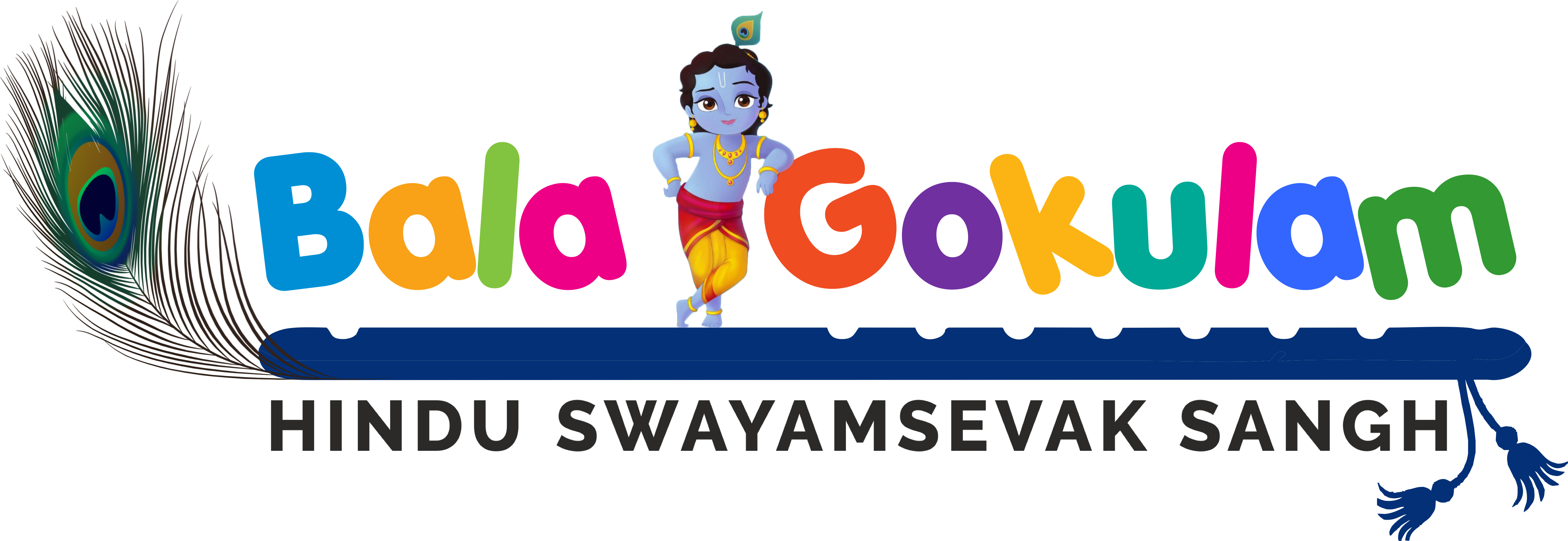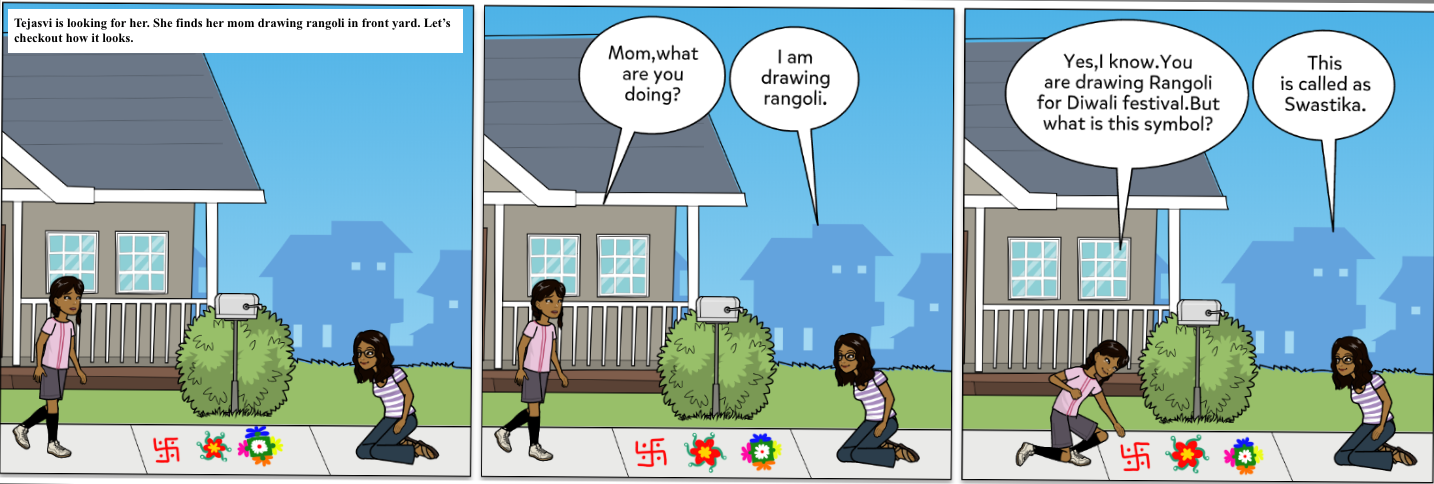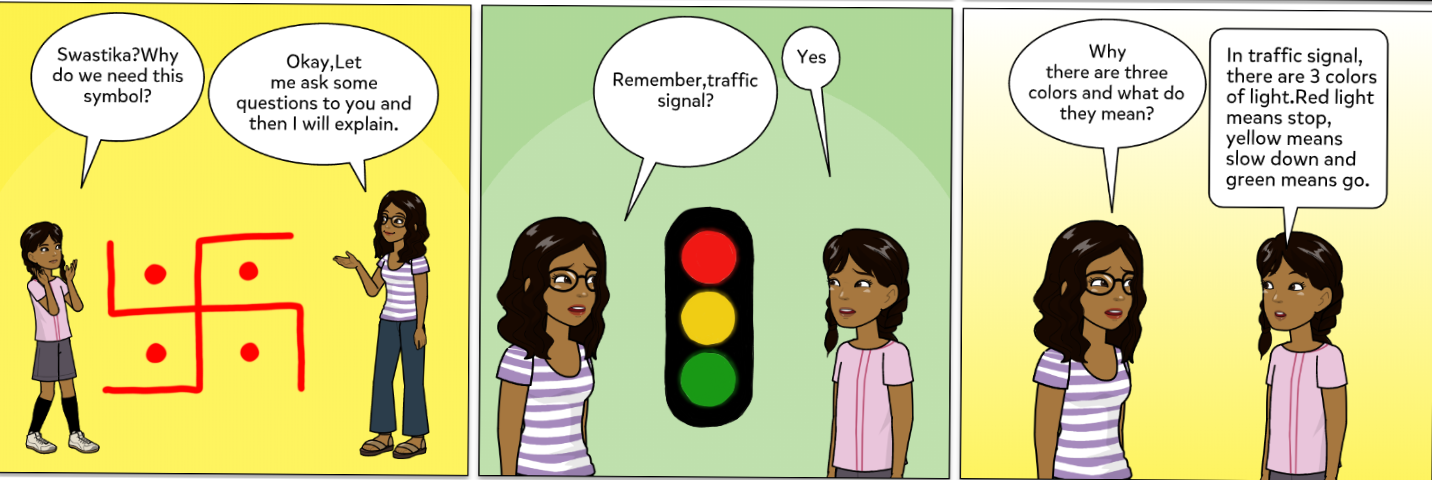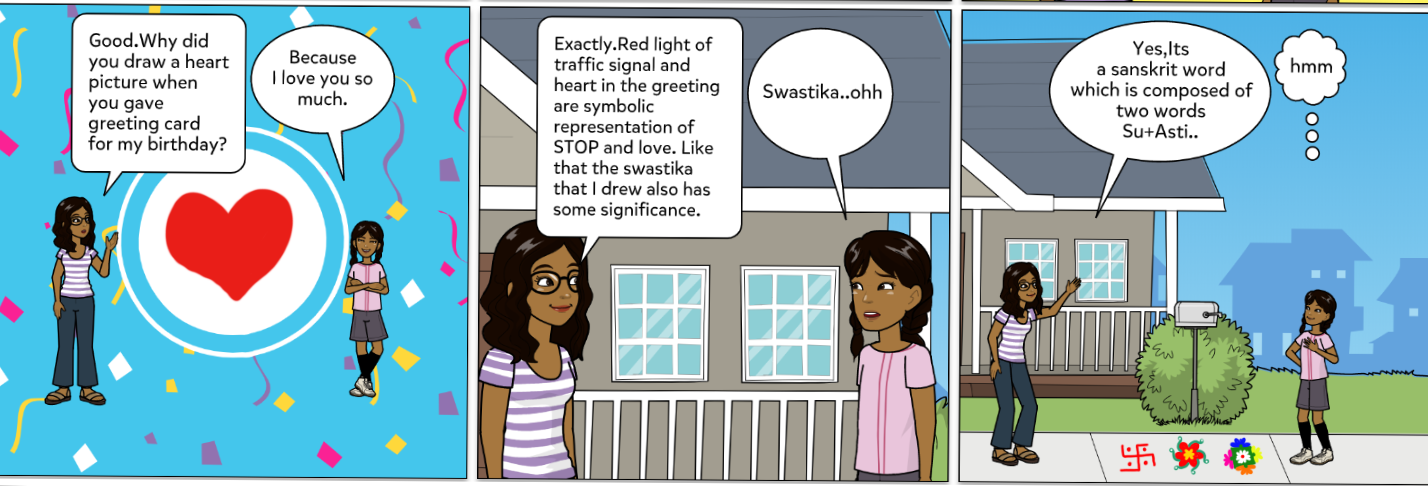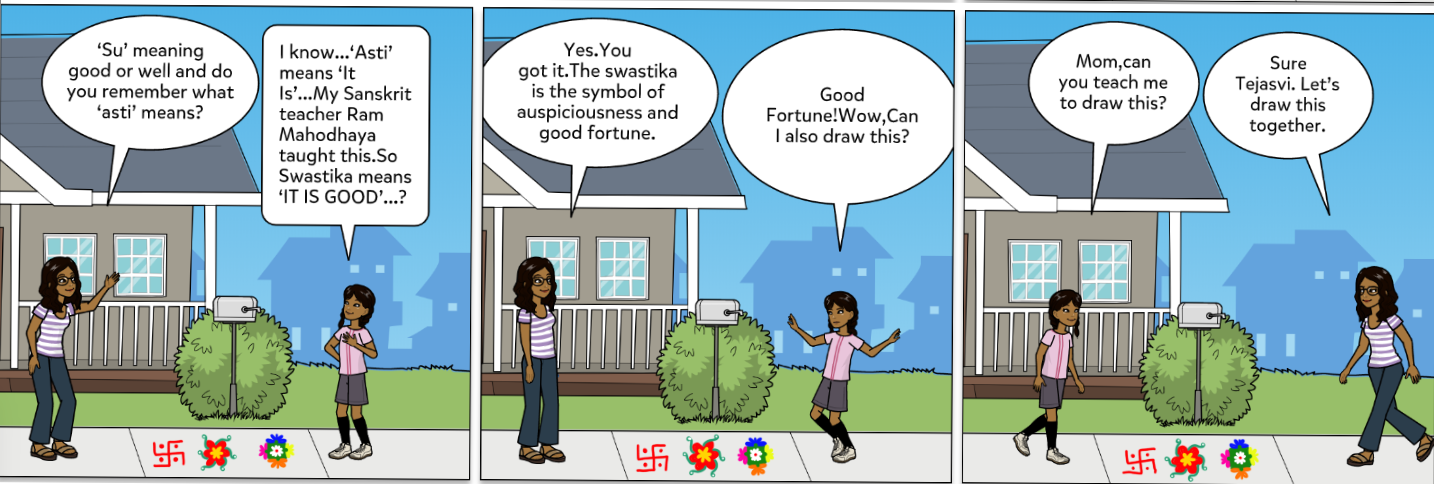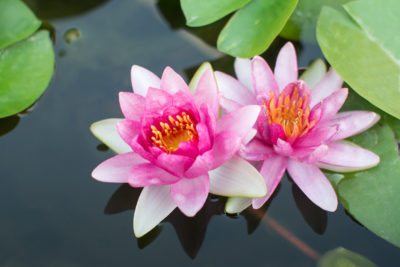Symbols and Scriptures
Dharma Bee 2020 – Discover Your Hindu Heritage
Week #4, Elementary School
Section 1 – Main Reading
SYMBOLS
We have many symbols that we come across in Hindu Dharma. Each symbol is divine and has a special meaning. Understanding those helps us become better because each one represents an aspect of Hindu way of life.
Tejasvi’s mom got her a gift for Deepavali. And she learns about one of the most important symbols in Hindu Dharma.
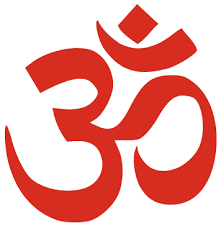 Aum is universal and represents Bhagawan, the divine. It is believed that when this universe was created, the first sound that came out was Aum. Hence, its sound is considered to create an auspicious beginning for any task that we undertake. And have you noticed? When you open your mouth, the sound emerging from the vocal cords starts from the base of the throat as “aa.” As you close your mouth, “uu” is formed and when the lips are fully closed, all sounds end in “mm.” Aum creates profound effect on the body and mind of the one who chants and also on the surroundings. The vibrations of Aum remove any negative qualities in us as we say it. So it is a frequently chanted sound by Hindus all over the world. Hindus repeat Aum as a mantra for meditation. We also greet each other saying ‘Hari Om’. Hindus worship and use this auspicious sign for all spiritual occasions. When you are angry or need something to calm you down or help you focus, just sit straight, close your eyes and chant Aum a bunch of times.
Aum is universal and represents Bhagawan, the divine. It is believed that when this universe was created, the first sound that came out was Aum. Hence, its sound is considered to create an auspicious beginning for any task that we undertake. And have you noticed? When you open your mouth, the sound emerging from the vocal cords starts from the base of the throat as “aa.” As you close your mouth, “uu” is formed and when the lips are fully closed, all sounds end in “mm.” Aum creates profound effect on the body and mind of the one who chants and also on the surroundings. The vibrations of Aum remove any negative qualities in us as we say it. So it is a frequently chanted sound by Hindus all over the world. Hindus repeat Aum as a mantra for meditation. We also greet each other saying ‘Hari Om’. Hindus worship and use this auspicious sign for all spiritual occasions. When you are angry or need something to calm you down or help you focus, just sit straight, close your eyes and chant Aum a bunch of times.
And feel the magic!
Let us learn about one more. The greeting Namaste!
Next time, you will also say Namaste to everyone you greet, won’t you? How do you do a proper Namaste? Place the hands together at the heart chakra, close your eyes, and bow your head. It can also be done by placing the hands together in front of the third eye, bowing the head, and then bringing the hands down to the heart. You are not only saying hi to the person you meet but also bowing down to the good qualities in the other person. At the same time, you are working on the pressure points on your fingertips! We also do Namaste during Puja. We bow in front of the God and close eyes and imagine God in our minds. This helps us look inwards and focus on yourself.
SCRIPTURES
Have you ever wondered what the holy books that Hindus follow are? Where do we get all this knowledge from? Veda learns more from her grandfather.
There are so many books we have don’t we? The 4 Vedas, 18 Puranas, 108 Upanishads and the Bhagavad Gita are the most important ones. Ancient Sages and Rishis from Bhaarat put together this knowledge for us after a lot of thinking and research. The word ‘Veda’ itself means knowledge. These Vedas might be as old as 8000 years. Can you imagine that? That makes it the oldest scripture known to mankind.
Ramayan and Mahabhaarat are also stories from our history that we can learn from. Ramayan is the life story of Sri Rama. And Mahabhaarat is the story of Sri Krishna, Pandavas and Kauravas.
Hindu Dharma doesn’t have just one book as a source of inspiration but many. All these texts teach us have to live and be a better human being.
Section 2 – Additional Reading
Additional Reading #1
More Symbols
Swastika
Why do we wear a bindi? (For Groups K-2 and 3-5)
Bhagwa (saffron color) represents the “sun”. The sun has the highest place in Vedic literature as the sustainer of all, one who takes care of everyone, and the source of energy. The sun acts as a reminder of the power of God, the act of selfless service and renunciation. The Bhagwa Dhwaj in the same way represents selfless service and righteousness. It stands for our sustained effort to uphold dharma through self-sacrifice. The Bhagwa dhwaj reminds us of our duty towards the Hindu community and the society as a whole. The bhagwa dhwaj can be found on Hindu temples and other Hindu religious sites.
Kamala (Lotus)
Lotus is a symbol of truth, auspiciousness and beauty (satyam, shivam, sundaram). God’s various aspects are compared to a lotus (i.e. lotus eyes, lotus feet, lotus hands, lotus of the heart). Hindu scriptures extol the beauty of the lotus. Many comparisons have been made to the nature of the Lotus. It blooms with the rising sun and closes at night. Similarly, our minds open up and expand with the light of knowledge. It grows in slushy areas yet remains beautiful and unpolluted despite its surroundings. Similarly, we should strive to remain pure and beautiful from within under all circumstances, not giving up on our basic nature of bliss. Lotus is also said to have emerged from the navel of Bhagwan Vishnu. Brahmaji originated from it to create the world. Hence, it also symbolizes the link between the creator and the protector. Lotus posture (padmaasana) is recommended when one sits for meditation. Lotus is also drawn as a rangoli for festive occasions. Lotus flowers are offered to the Hindu deities during pujas.
Kalash (For Group 3-5)
A kalash is a pot filled with water. Mango leaves are placed in the mouth of the pot and a coconut is placed over it. Sometimes red and white threads are tied around the Kalash. The water in it symbolizes the giver of life and from which the entire creation is emerged. The mango leaves and coconut represent creation and the threads around it signify the love that binds all in creation. The kalash is therefore considered auspicious and worshipped. It is used to greet learned men acknowledging their greatness and knowledge of the infinite Truth and as a sign of respectful welcome. It is also used in pujas in temples invoking the holy rivers, the knowledge of Vedas and the gods’ blessings.
Shree (For Group 3-5)
The syllable Shri (also spelled as Sri and Shree) is equally popular and sacred in Hindu Dharma. It is used in prayers and invocations and in front of the names of gods, goddesses as a prefix to denote their purity and power and their connection with the Mother Goddess. In fact it is used in front of people’s names as well as a sign of respect.
Symbolically, ‘Shri’ represents the Mother Goddess, especially, Lakshmi, the Goddess of Wealth. Shri is a combination of two sacred syllables or sounds (bija mantras) namely ‘Sha’ or ‘Shi’ and ‘Hri.’ ‘Shi’ represents destruction of impurities. Shiva also starts with Shi because he is the god who dissolves. When the negative and impurities are destroyed, only the pure, the best is left. Hence, he is Shivam (pure and auspicious). ‘Hri’ represents the Goddess and creation. So ‘Shi’ purifies and ‘Hri’ creates or heals. Together it makes a very powerful sound that represents auspiciousness, purity, tranquility, good fortune, health, peace, prosperity, etc.
Additional Reading #2
More on Scriptures
Ramayan
Ramayana is the story of Sri Rama, the seventh avataar of Vishnu. This epic has 8 kandas or parts to it.
Watch it on YouTube:
Source 1 – English; duration is about 1 hour
https://www.youtube.com/watch?v=UA2BYSivPXA
Source 2 – English; duration is about 2 hours
https://www.youtube.com/watch?v=3yf-kYqivn0
Source 3 (For Group 3-5) – English; Series of 12 videos which goes by Kanda to Kanda by Geethanjali – Cartoons for Kids
https://www.youtube.com/watch?v=5-78B_XoDHk&list=PLfv3tA5AoEjDRTEN3GMPnnF0iyVHT9YtI
Mahabhaarat
Mahabhaarat is the story of Pandavas and Kauravas and right versus wrong. Mahabhaarat also has Sri Krishna in it, the eighth avataar of Vishnu. This epic has 18parvas or parts to it.
Source 1 – English; duration is about 1 hour
https://www.youtube.com/watch?v=Xx4H_yuZbmU
Source 2 (For Group 3-5) – English; Series of 5 videos covering the major parvas by Geethanjali – Cartoons for Kids
https://www.youtube.com/watch?v=RAkrfD-l9HU&list=PLfv3tA5AoEjBx4p2Cb5z_K2LnhKxPugoS
Katha Upanishad and Story of Nachiketa
We are going to learn about Kathopanishad or Katha Upanishad and its teachings through a story. Upanishads are part of Vedas that contain central ideas and concepts of our
Sanatana Dharma. Upanishad in Sanksrit translates to “sitting at the feet of” or “sitting down near.” This illustrates the position of receiving wisdom and guidance humbly from a teacher or guru. Though there are many Upanishads, only a select few are considered the Mukhya (Principal) Upanishads and are part of the core Vedas and Katha Upanishad is one of them.
The central story of Katha Upanishad is so old that the name Nachiketa is mentioned in the Yajur Veda. Katha Upanishad is part of the Yajur Veda. It is the most widely translated Upanishad and many western philosophers have incorporated it as the central theme in their works. The story is what is explained in detail here with a simple explanation of the philosophy embedded in it. This is to make it suitable for children and to introduce them to our Vedanta philosophy.
Introduction
Once upon a time there lived a learned sage by named Vaajasravasa. He was also known as Aruni Auddalaki Gautama. He had a son by name Nachiketa who at that time was a small boy. One day, Gautama wanting to receive more wealth and other pleasures did a Sarva Dakshina Yagna, whereby you give away everything you possess to poor people. Nachiketa saw his father giving away cows and other gifts to the poor in need of money. But he was surprised to see that the cows were old and tired, those which have stopped giving milk and the gifts were those that they did not use any more. Nachiketa was confused. He thought, “If my father needed to do the Yagna properly he needs to give away the healthy cows. Why is he giving away the old and useless cows and unusable gifts. Should he not give the best away so that he gets the full fruits of the Yagna?”
Nachiketa questions his father
Nachiketa thinks deeply and comes to a conclusion. If my father needs the best result he needs to give his best possession away. I am his son and therefore I am his best possession and he needs to give me away. Thinking thus, Nachiketa approaches his father and asks, “Father, Since you are giving everything away, to whom do you propose to offer me as a gift?” The father ignores him and Nachiket keeps pestering him. After the third time the father irritated says loudly, “I plan to give you away to Yama – The deva of death!”
Though the father said it out of anger and did not mean it, what is promised has to be kept. Vaajasravasa is full of remorse and wants to take back what he said out of anger. But
Nachiketa says to his father, “Well, whatever you have said is all right”. “Don’t withdraw your words. Remember our ancestors who have adhered to truth always. Let it be so, although it may be unpleasant. Though you might have unwittingly, in anger, said it, don’t take it back”. Saying so Nachiketa goes on to meet Yama.
Nachiketa meets Yama
Nachiketa reaches the abode of Yama and finds that Yama has gone out and was not at home. Since this is the abode of Death, Yama’s wife and family cannot call Nachiketa into their home as it has to be decided only by Yama. So for three days Nachiketa waits at the doorstep for Yama without food or water. Yama comes back after three days and his wife tells him, “O Yama, O Master of Death, there is a guest waiting for you without food or water. The atithi’s hunger is burning our house like fire. Please immediately give him food and water.” Yama tells his wife, “Please take care of him. Let him not burn. Do invite him and give him food and water”.
In our dharma an atithi (guest) who comes even without any advanced notice needs to be treated like Bhagawan. So a guest should not be neglected under any condition. That’s why we say “Atithi devo bhava”. Once Nachiketa is given food and water, Yama goes before Nachiketa and says, “Dear young one, you have fasted in our house for three days without food and water. The only way to correct this mistake is to offer you three boons, one for each day of fasting. Please ask from me anything for these three boons.” Nachiketa asks Yama three different boons one after another.
Three Boons
Nachiketa asks to return to home in the first boon. For his second and third, he asks to know more about living life and what happens after death. Yama, impressed by his thirst for knowledge grants all three boons.
Nachiketa asks these questions not just for himself but for others to also know and learn. This Upanishad talks in detail the secret of understanding the Brahman – God or divinity that exists all around us by understanding the meaning of Aum which is the name and symbol of the Brahman. This also details out the process of understanding the about oneself and the purpose of yoga and meditation. We will explore more about Yoga in one of the future weeks.
Section 3 – Take Away and Questions
Take Away for this week:
- Each symbol we have and use has a meaning and teaches us something. They are very divine and holds a special place.
- Think about what each symbol introduced above means.
- We do not have just one source of knowledge or book but many. These are collections put together by our rishis and sages. “Vedas” are considered the oldest scriptures in the world.
- We have:
- 4 Vedas
- 18 Puranas
- 108 Upanishads
- And epics like Ramayana and Mahabhaarat
Explore:
- MY ROUTINE: Which Hindu symbols do you see around you? At home? At temple? Anywhere else? How are they used?
- THINK: Think about the characters in Ramayana and Mahabhaarat. What do you learn from them? What do you learn from the story itself?
Questions:
1. AUM has ______ sounds.
a. 2 b. 3 c. 4 d. none of these
2. The first sound of the universe is called ___________
3. There are __________ Vedas.
a. 2 b. 3 c. 4 d. none of these
4. We bow down to the divinity in others by doing ___________.
5. Being in proper posture is important while doing a Namaste. True or False.
6. Studying the scriptures helps us be a better human being and learn more about our culture. True or False.
7. There are __________ Puranas.
a. 10 b. 12 c. 18 d. 24
8. The word ‘Veda’ means ___________.
a. knowledge b. scripture c. book d. none of these
9. Bindi is worn between the eyebrows. True or False.
10. Which of these are the oldest scriptures in the world?
a. Upanishads b. Puranas c. Ramayana d. Vedas
For Group 3-5
1. Which of the following about AUM is FALSE?
a. Chanting AUM calms you down
b. AUM is the sound that came at the end of universe
c. AUM has 3 sounds
d. None of these
2. Nachiketa asked for ________ number of boons.
3. Who did Nachiketa ask the boons from?
4. Upanishad means “sitting near”. True or False.
5. Katha is name of one of the _______________.
a. Upanishads b. Puranas c. Ramayana d. Vedas
6. Name the 4 Vedas.
7. Shree is made of two sounds “Shi” and “hri”. True or False.
8. In the sound/symbol Shree, Shi stands for Lakshmi and Hri stands for Shiva. True or False.
9. Bhagwa Dhwaj represents
a. righteousness b. sun c. selfless service d. all of these e. none of these
10. Ramayana and Mahabhaarata are called _________________
a. Puranas b. Itihaasa c. Upanishads d. Vedas
11. _____________ emerged from navel of Vishnu.
a. Swastika b. Bhagwa Dhwaj c. Lotus d. AUM
12. _______________ is used in special pujas and invoke waters of holy rivers.
a. Kalash b. Lotus c. Swastika d. None of these
Describe the significance of each.
1. AUM
2. Namaste
3. Bindi
4. Swastika
5. Bhagwa Dhwaj
6. Kalash
7. Shree
